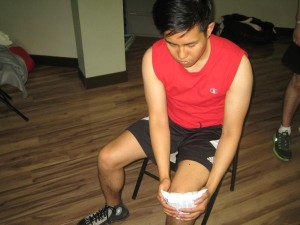The fat pad of the knee is a soft tissue structure beneath the kneecap. This pad is covered by the thigh bone and shin bone. Since the fat pad is highly innervated, it is a highly sensitive structure in the knee joint.
Once it is irritated, the fat pad can trigger intense knee pain and discomfort. Since it rests beneath the knee cap, it can lead to squeezing or impingement on the fat pad especially if there are issues with the kneecap alignment.
What are the causes?
- Forceful or strong blow to the front part of the knee such as in football tackle, falls or vehicular accidents
- Taut quadriceps
- Scarring or subsequent fibrosis of the fat pad
- Excessive knee extension
- History of knee osteoarthritis
- Forward tipping pelvis
Indications

Fat pad syndrome might trigger some of these symptoms:
- Knee pain especially in the front area
- Swelling beneath and around the joint
- Discomfort when wearing high-heeled shoes
- Pain or achiness when straightening the knee completely
- Pain after prolonged squatting, walking or kicking
It is important to note that these symptoms are the same as other knee conditions including patellofemoral joint pain syndrome and patellar tendonitis. Due to this, it is vital to consult a doctor for proper assessment of the condition.
Management of fat pad syndrome
The commonly used treatment options might include the following:
- Decreasing the pain and inflammation with application of ice, electrotherapy, acupuncture, therapeutic taping and gait education
- Strengthening of the leg and knee muscles
- Normalizing the range of motion of the muscles and joints
- Improving agility, proprioception, landing technique and function
In case the knee pain and other symptoms persist, surgery of the fat pad might be an option. The surgery might involve arthroscopic debridement or partial removal of the fat pad.
Prevention
The ideal approach to avoid the return of fat pad impingement is to improve the flexibility and strength of the muscles surrounding the knee, ankle and hip.
It is also vital to avoid any aggravating activities such as squatting, kneeling and kicking for extended periods. Among women, it is vital to avoid or limit walking using high heels.
